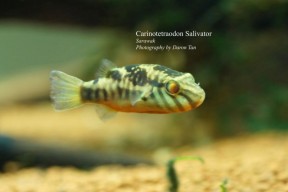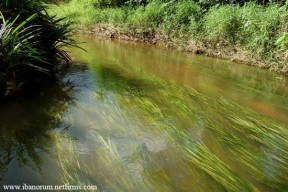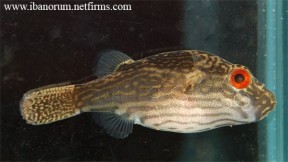Carinotetraodon salivator
Etymology
Carinotetraodon: from the Latin carina, meaning ‘keel’, and the generic name Tetraodon, within which members have formerly been included.
salivator: from the English salivator, meaning ‘who is salivating’, in reference to the pale blotch on the lower lip in this species, which resembles a drop of saliva.
Classification
Order: Tetraodontiformes Family: Tetraodontidae
Distribution
Known only from the Malaysian state of Sarawak, Borneo, with records from the Lupar, Sarawak, and Rajang river systems.
Type locality is ‘Sungai Bejit, kilometer 10 on road to Simunjan, 1°08’39″N, 110°53’43″E, Sarawak state, Borneo, East Malaysia’.
Habitat
Unlike the majority of congeners, there is evidence to suggest that C. salivator displays a preference for flowing water. In 1992 the type locality was a stream approximately 15 metres wide with clayey, steep margins lined with exposed tree roots and shrubs. Substrates varied between soft silt and sand with leaf litter and submerged logs, with at least one rocky, riffle-like stretch. The water exceeded two metres in depth in places, although C. salivator was collected from shallower, marginal areas, especially among leaf litter and submerged roots.
Other collection localities comprised a riffle section of a forest stream with clear, fast-flowing water, and a relatively fast-flowing, deep (1.5-2 m) blackwater stream draining an area of peat swamp.
Sympatric fish species included Rasbora cephalotaenia, Homalopteroides nebulosus, Nemacheilus spiniferus, Hemirhamphodon kuekenthali, Doryichthys deokhatoides, and Luciocephalus pulcher.
Maximum Standard Length
40 – 50 mm.
Aquarium SizeTop ↑
An aquarium with dimensions of 60 ∗ 30 ∗ 30 cm or equivalent should be the smallest considered.
Maintenance
This species requires a well-decorated aquarium with driftwood roots or branches plus plenty of aquatic plants, of which floating varieties can be used to provide additional shade. The addition of dried leaf litter further emphasises the natural feel and as well as offering cover brings with it development of microbe colonies which can provide a valuable early food source for fry
A degree of water movement may also be appreciated, and regular small water changes are recommended since this species is sensitive to deteriorating conditions.
Water Conditions
Temperature: 20 – 28 °C
pH: 5.0 – 7.5
Hardness: 18 – 215 ppm
Diet
Tetraodontids lack true teeth, the jawbone itself being modified into four fused toothlike structures. These grow continuously at a surprising rate, so offer regular meals of shelled invertebrates such as snails, small crab legs, cockles, etc., in order to maintain them at a reasonable length. There is some evidence to suggest that aufwuchs form a significant proportion of the natural diet, therefore it may be worth permitting or even encouraging algal growth on hard items of décor.
Additional foods can include chopped shellfish, small earthworms, and live or frozen chironomid larvae (bloodworm), Artemia, etc. Dried products should not form the principal component of the diet, although pelleted formats with a very hard consistency may prove useful.
Behaviour and CompatibilityTop ↑
Less aggressive than some members of the genus but nevertheless best maintained alone or alongside a group of peaceful, schooling cyprinids of a size large enough to escape predation but small enough that they offer no competition or threat.
It is only loosely gregarious, males in particular tending to be territorial, but a group can be maintained provided sufficient cover and space is available.
Sexual Dimorphism
Adult males possess well-developed dorsal and ventral keels on the body, which are erected during threat displays and courtship. In addition the ventral surface is red with 3-5 cross bars anteriorly in males, cream-coloured with dark stripes in females.
Reproduction
Unrecorded. The congener C. lorteti is known to scatter its eggs among vegetation, with the male guarding the brood during incubation.
NotesTop ↑
C. salivator is sometimes traded as ‘striped redeye puffer’ or zebra puffer’.
It is included in a group often referred to as ‘red-eyed puffers’, which currently contains four recognised species distributed in Indochina and the Greater Sunda Islands. It can be distinguished from C. borneensis, C. irrubesco, and C. lorteti, the remaining members of this group, by the following combination of characters: 11 dorsal-fin rays; 16 pectoral-fin rays; 11-13 anal-fin rays; 11 caudal-fin rays; eyes not bulging above the head; in males dorsal-fin hyaline, black spot on dorsal-fin base present, pectoral-fin base hyaline, anal-fin hyaline with no black spot at base, caudal-fin reddish, throat with a barred colour pattern, bars present on body; in females ventral surface with continuous black stripes, 7-8 bars on caudal-fin.
Carinotetraodon is distinguished from other genera within the family Tetraodontidae by the presence of distinctive dorsal and ventral keels in males, plus distinct sexual dimorphism in terms of both morphology and colour pattern. Tetraodontidae is the most speciose group among Tetraodontiformes and its members mostly inhabit coastal waters in South America, Central Africa, and Southeast Asia. It is the only tetraodontiform family in which a number of members exclusively inhabit freshwater, and genetic evidence suggests that the timing of these invasions differed, occurring around 0–10 million years ago (MA) in South America, 17–38 MA in Central Africa and 48–78 MA in Southeast Asia.
Tetraodontids are commonly referred to as ‘puffers’ due to the ability of many species to inflate their body to an enormous size when stressed or threatened. This is achieved by drawing water into a specialised ventral diverticulum of the stomach, although air can also be used if the fish is removed from the water. As a result of these morphological adaptations puffers swim via a unique combination of pectoral and median fin undulations referred to as ‘diodontiform’ swimming. They are also able to produce sounds by grinding the jaw/pharyngeal teeth or vibrating the swim bladder. Puffers are secondary freshwater fishes, with the majority of members exclusively inhabiting marine environments.
Other defining characters of tetraodontids include a tough skin usually covered with small spines, a beak-like dental plate divided by a median suture, a reduced gill opening anterior to the pectoral-fin base, no pelvic fins or spinous fin rays, typically short-based dorsal and anal fins, and no ribs.
Puffer flesh is toxic and can cause clinical poisoning and human mortality, although it is regarded as a delicacy in certain countries. The predominant toxin, usually either tetrodotoxin or saxitoxin, is dependant on species, geographic area, and time of year. The toxins are not produced by the fishes themselves, but by bacteria living in symbiotic association, or they are acquired via the food chain.
References
- Lim, K. K. P. and M. Kottelat, 1995 - Japanese Journal of Ichthyology 41(4): 359-365
Carinotetraodon salivator, a new species of pufferfish from Sarawak, Malaysia (Teleostei: Tatraodontidae). - Britz, R. and M. Kottelat, 1999 - Journal of South Asian Natural History 4(1): 39-47
Carinotetraodon imitator, a new freshwater pufferfish from India (Teleostei: Tetraodontiformes). - Ebert, K., 2001 - Aqualog, Rodgau: 1-96
The puffers of fresh and brackish waters. - Kottelat, M., 2013 - Raffles Bulletin of Zoology Supplement 27: 1-663
The fishes of the inland waters of southeast Asia: a catalogue and core bibiography of the fishes known to occur in freshwaters, mangroves and estuaries. - Tan, H. H., 1999 - Ichthyological Exploration of Freshwaters 10(4): 345-354
A new species of Carinotetraodon from Sumatra and Borneo and validity of C. borneensis (Teleostei: Tetraodontidae). - Yamanoue, Y., M. Miya, H. Doi, K. Mabuchi, H. Sakai and M. Nishida, 2011 - PLoS ONE 6(2): e17410
Multiple Invasions into Freshwater by Pufferfishes (Teleostei: Tetraodontidae): A Mitogenomic Perspective.






